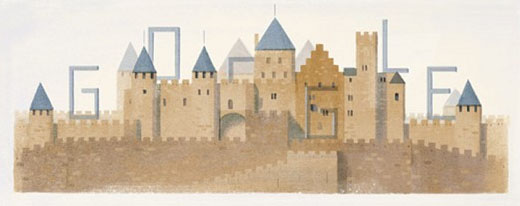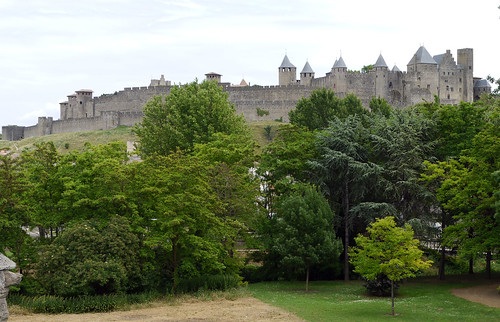
The recent Google Doodle celebrating the 200th anniversary of the architect who renovated the walled city of Carcassonne brought back happy memories of my visit there in 2012.
From the Telegraph regarding the man and his anniversary:
Eugene Viollet-le-Duc, the architect known for his distinctive restoration work on medieval buildings, has been celebrated with a Google doodle.
The doodle depicts one of Viollet-le-Duc’s designs and celebrates what would have been his 200th birthday today.
Born in France, Viollet-le-Duc was involved in the July Revolution of 1830 and embraced republicanism and anti-clericalism.
The French theorist started restoring medieval buildings in 1835 and achieved national fame with his work at Notre Dame de Paris.
Viollet-le-Duc became known for the gothic elements of his designs and for combining historical fact with creative modifications, which led to criticism from his contemporaries and John Ruskin.
His works also included Basilica of St Denis near Paris, Carcassonne and Chateau de Pierrefonds.
As well as his work on restorations he was considered a theorist on modern architecture, making numerous drawings.
He had a second career in the military, defending Paris during the Franco-Prussian war from 1870 to 1871 and developing theories of defence that were to influence the engineers behind fortifications for both the first and second world wars.
Viollet-le-Duc later relocated to Switzerland where he built a villa, and remained there until his death in 1879.
The walled city (La Cite) of Carcassonne was built on the site of a former Roman fortress. The city is protected by two heavily fortified walls and has no less than 52 towers and barbicans. In medieval times Simon de Montfort led crusades against the Albigensians (Cathars) whom the Catholic Church had branded as heretics due to their beliefs.
At that time that city and its inhabitants were under the protection of Raymond Trencavel, “Vicomte de Carcassonne”. The town surrounding the city was destroyed during these crusades and King Louis IV authorised the building of the Bastide on the left bank of the river Aude as a replacement.
When the Roussillon region became part of France in 1659 the city’s strategic importance as a border fortress declined, the inhabitants moved to the lower town and the city fell into disrepair. In 1844 the architect Viollet-le-Duc was put in charge of the restoration of Saint-Nazaire and Saint-Celse basilica and subsequently he undertook a study of all the city fortifications. This study was used as a basis for the restoration of the city and its fortifications.









Don’t you just love Google Art…especially when it fits right into your own life’s experiences!
I always enjoy seeing a Google Art, some of the art teaches me new things
But this one spoke to me because I loved Carcassonne when I visited in 2012. This Google Art, though modern in interpretation, represents the walled town exactly as it is
My photo is from a slightly different angle, but the towers in the artwork can be seen quite easily in it.
Damn, forgot to buy a present.
For me or for Viollet?
Hello from Southern California – just want to say thank you for your recent visit and comments on my blog. I’ve just been perusing you latest posts and see I must visit here more often! You have such interesting tidbits to offer and lots of information. And your photos are wonderful too. It is wonderful to be able to visit far-away places through others’ words and photos. Thank you!
Thank you for your kind words
I enjoy to seeing different perspectives of the world through other peoples eyes.
Revisit Carcassonne in 2014,perhaps?
That part of France is calling me back